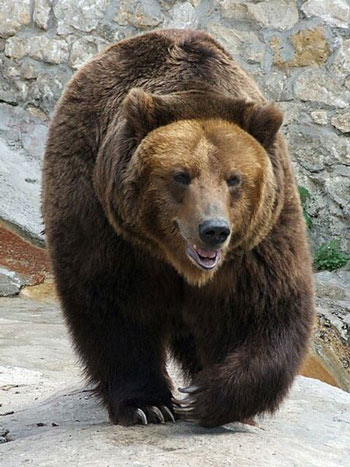11 Mai 2017
Brown bears are brown, right? They come in all sizes and shades, from a light cream color to almost black. It was once thought that there were 8. North America alone. Today, scientists agree that there is only one species of brown bear with a lot of variations (or subspecies).

Bears found in parts of coastal Alaska are called Kodiak or Alaskan brown bears and tend to be the largest of the species. This is from eating salmon rich in fat every summer. The Alaskan peninsular brown bear has a much smaller range: just the western tip of the Alaskan peninsula.
Brown bears in interior North America are known as grizzly bears because their brown fur is tipped with white or tan; the word . All bears have short, thick limbs, a big, heavily built body, and a large head. Look carefully and you’ll notice that most bears walk pigeon- toed, with their feet turned inward. It makes them look a little clumsy when they’re walking, but don’t be fooled—bears can move much more quickly than most people realize. Adult brown bears are not quite as comfortable in trees as their panda, black, sun, and sloth bear relatives, although brown bear cubs are encouraged to climb for safety.
Brown bears have a large hump of muscle on top of their shoulders, and grizzly bears have the most distinctive hump of all. Their great front claws make all brown bears powerful diggers. They may build a shallow bed on the ground made of leaf litter. When the weather cools, they seek out large, cozy dens for their winter home.

A den can be a rock cave, a tree hollow, a pile of brush, or a den made by digging into a hillside or under tree roots. Brown bears can spend four to six months a year curled up deep in sleep, in a den. That's one- third to one- half of their lifetime!
This sleep is commonly called hibernation, but unlike true hibernation, the bears' body temperature does not drop drastically. However, the bears' heart rate slows from 7. This . Bears in warmer climates spend less of their time curled up in their dens than those in areas with a longer winter. In fact, the brown bears at the San Diego Zoo stay active year round!

Bears are the only mammals that do not pee or poop for the entire time they are in their winter sleep! In fact, by studying the way bears recycle urine, doctors have been able to help human patients with kidney failure.

Brown bear videos, photos and facts - Ursus arctos. An opportunistic feeder, the brown bear has a varied omnivorous diet which consists predominantly of berries and nuts, but also includes grasses, roots, insects, salmon, small mammals and large ungulates(2)(4). Larger animal prey may be either taken as carrion or actively hunted, particularly by grizzly bears. Probably the most carnivorous subspecies, these formidable predators can bring down moose, elk and even black bears.

While the brown bear may be encountered throughout the day, it is mostly active during the early morning and evening. Seasonal movements are made in response to food aggregations, such as spawning salmon, during which time large numbers of bears may gather in relatively small areas (4). Brown bears have extremely large home ranges, varying from 2. While typically solitary, brown bears tolerate the presence of conspecifics and do not appear to be territorial, although adult males may fight for dominance (4).
During the mating season, from May to July, the males compete for females (4), and dominant males may attempt to guard a chosen mate from rival males while the female is in oestrus(5). Both males and females may mate with several different partners, and may also form short- lived pair bonds lasting from several weeks to a few hours (5). After mating, the fertilised eggs undergo delayed development and do not implant in the female’s womb until around November (2). Thereafter, the eggs continue development with the young born between January and March, resulting a total gestation period of 6. The reason for this delayed development is that it causes the cubs to be born during the winter hibernation, allowing maximum time until the following winter for the cubs to grow large enough to survive hibernation without the mother (2). A litter of between one and four cubs is produced, which are weaned at five months and reach reproductive maturity at four to six years old (4).
Today, I'm going to display some of the least known koala bear facts for kids including koala bear diet, distribution, reproduction, and behavior. As brown bear breeding season approaches (May to July), the boars become more aggressive toward each other. To show dominance, they stand upright, growling and. This article covers all the essential Wood Duck facts that are rarely known. These facts include wood duck habitat, diet, and breeding. Alaska Department of Fish and Game. Kodiak Bear Fact Sheet. Kodiak bears are a unique subspecies of the brown or grizzly bear (Ursus arctos middendorffi).
Red Panda: habitat, facts & information, endangered, lifestyle, diet, breeding, baby, sounds, behavior.
The first litter is usually produced between the ages of five and ten, and there is usually a period of two to five years between successful litters (2). Like all northern bears, brown bears hibernate throughout winter, preserving energy by reducing heart rate and body temperature by a few degrees. Hibernation takes place in a den, often dug into a sheltered slope, in which the bear may survive for over half a year without eating, drinking, urinating or defecating (2)(4). This remarkable feat is achieved by utilising stored fat for energy and by recycling waste products normally excreted as urine to conserve fluids and produce amino acids. Incredibly, the female brown bear is also able to give birth and nurse a litter of cubs during hibernation, although the energetic cost is high and can incur a 4.